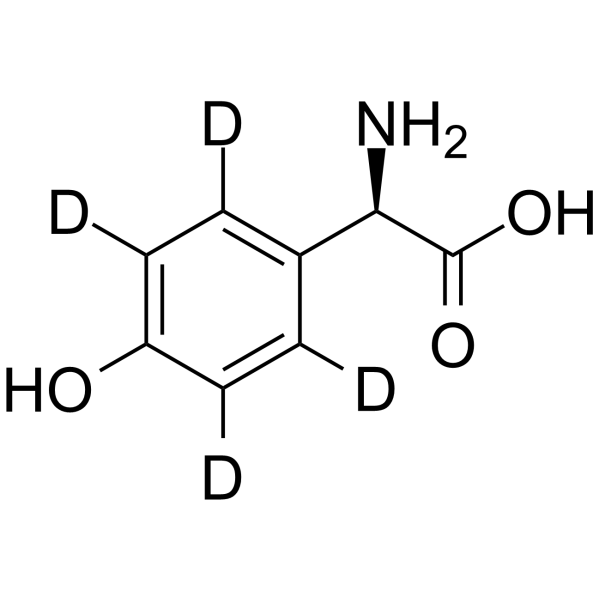D-(-)-4-Hydroxyphenyl-d4-glycine
Modify Date: 2024-01-01 22:13:28

D-(-)-4-Hydroxyphenyl-d4-glycine structure
|
Common Name | D-(-)-4-Hydroxyphenyl-d4-glycine | ||
|---|---|---|---|---|
| CAS Number | 1217854-79-9 | Molecular Weight | 171.18700 | |
| Density | N/A | Boiling Point | N/A | |
| Molecular Formula | C8H5D4NO3 | Melting Point | N/A | |
| MSDS | N/A | Flash Point | N/A | |
Use of D-(-)-4-Hydroxyphenyl-d4-glycineD-4-Hydroxyphenylglycine-d4 (D-(-)-4-Hydroxyphenylglycine-d4) is the deuterium labeled D-4-Hydroxyphenylglycine. D-4-Hydroxyphenylglycine (D-(-)-4-Hydroxyphenylglycine) is one of the most important raw materials used in the production of semisynthetic β-lactam antibiotics, such as Amoxicillin (HY-B0467A) and Cefadroxil (HY-B1190)[1]. |
| Name | D-(-)-4-Hydroxyphenyl-d4-glycine |
|---|---|
| Synonym | More Synonyms |
| Description | D-4-Hydroxyphenylglycine-d4 (D-(-)-4-Hydroxyphenylglycine-d4) is the deuterium labeled D-4-Hydroxyphenylglycine. D-4-Hydroxyphenylglycine (D-(-)-4-Hydroxyphenylglycine) is one of the most important raw materials used in the production of semisynthetic β-lactam antibiotics, such as Amoxicillin (HY-B0467A) and Cefadroxil (HY-B1190)[1]. |
|---|---|
| Related Catalog | |
| In Vitro | Stable heavy isotopes of hydrogen, carbon, and other elements have been incorporated into drug molecules, largely as tracers for quantitation during the drug development process. Deuteration has gained attention because of its potential to affect the pharmacokinetic and metabolic profiles of drugs[1]. |
| References |
| Molecular Formula | C8H5D4NO3 |
|---|---|
| Molecular Weight | 171.18700 |
| Exact Mass | 171.08300 |
| PSA | 83.55000 |
| LogP | 1.17690 |
| (2R)-2-amino-2-(2,3,5,6-tetradeuterio-4-hydroxyphenyl)acetic acid |